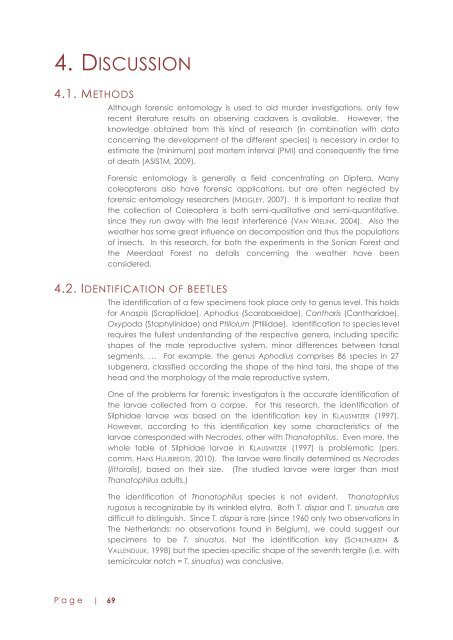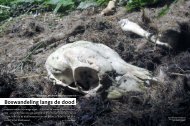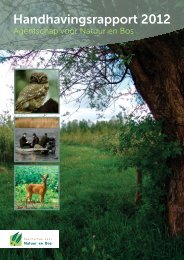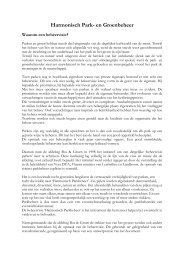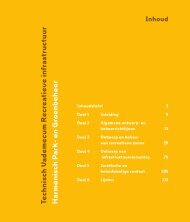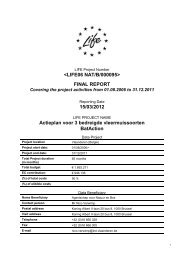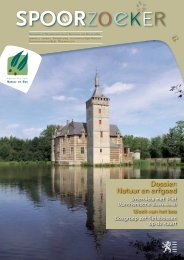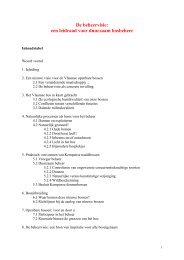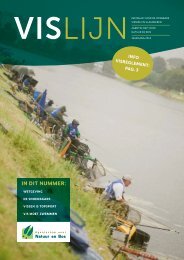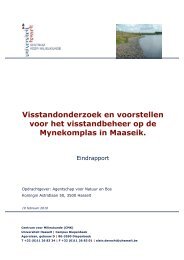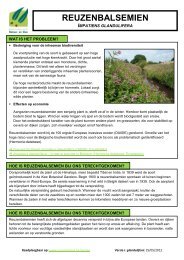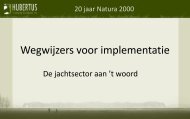4. DISCUSSION4.1. METHODSAlthough for<strong>en</strong>sic <strong>en</strong>tomology is used to aid murder investigations, only fewrec<strong>en</strong>t literature results on observing cadavers is available. However, theknowledge obtained from this kind of research (in combination with dataconcerning the developm<strong>en</strong>t of the differ<strong>en</strong>t species) is necessary in order toestimate the (minimum) post mortem interval (PMI) and consequ<strong>en</strong>tly the timeof death (ASISTM, 2009).For<strong>en</strong>sic <strong>en</strong>tomology is g<strong>en</strong>erally a field conc<strong>en</strong>trating on Diptera. Manycoleopterans also have for<strong>en</strong>sic applications, but are oft<strong>en</strong> neglected byfor<strong>en</strong>sic <strong>en</strong>tomology researchers (MIDGLEY, 2007). It is important to realize thatthe collection of Coleoptera is both semi-qualitative and semi-quantitative,since they run away with the least interfer<strong>en</strong>ce (VAN WIELINK, 2004). Also theweather has some great influ<strong>en</strong>ce on decomposition and thus the populationsof insects. In this research, for both the experim<strong>en</strong>ts in the Sonian Forest andthe Meerdaal Forest no details concerning the weather have be<strong>en</strong>considered.4.2. IDENTIFICATION OF BEETLESThe id<strong>en</strong>tification of a few specim<strong>en</strong>s took place only to g<strong>en</strong>us level. This holdsfor Anaspis (Scraptiidae), Aphodius (Scarabaeidae), Cantharis (Cantharidae),Oxypoda (Staphylinidae) and Ptiliolum (Ptiliidae). Id<strong>en</strong>tification to species levelrequires the fullest understanding of the respective g<strong>en</strong>era, including specificshapes of the male reproductive system, minor differ<strong>en</strong>ces betwe<strong>en</strong> tarsalsegm<strong>en</strong>ts, … For example, the g<strong>en</strong>us Aphodius comprises 86 species in 27subg<strong>en</strong>era, classified according the shape of the hind tarsi, the shape of thehead and the morphology of the male reproductive system.One of the problems for for<strong>en</strong>sic investigators is the accurate id<strong>en</strong>tification ofthe larvae collected from a corpse. For this research, the id<strong>en</strong>tification ofSilphidae larvae was based on the id<strong>en</strong>tification key in KLAUSNITZER (1997).However, according to this id<strong>en</strong>tification key some characteristics of thelarvae corresponded with Necrodes, other with Thanatophilus. Ev<strong>en</strong> more, thewhole table of Silphidae larvae in KLAUSNITZER (1997) is problematic (pers.comm. HANS HUIJBREGTS, 2010). The larvae were finally determined as Necrodes(littoralis), based on their size. (The studied larvae were larger than mostThanatophilus adults.)The id<strong>en</strong>tification of Thanatophilus species is not evid<strong>en</strong>t. Thanatophilusrugosus is recognizable by its wrinkled elytra. Both T. dispar and T. sinuatus aredifficult to distinguish. Since T. dispar is rare (since 1960 only two observations inThe Netherlands; no observations found in Belgium), we could suggest ourspecim<strong>en</strong>s to be T. sinuatus. Not the id<strong>en</strong>tification key (SCHILTHUIZEN &VALLENDUUK, 1998) but the species-specific shape of the sev<strong>en</strong>th tergite (i.e. withsemicircular notch = T. sinuatus) was conclusive.P a g e | 69
4.3. <strong>LABOULBENIALES</strong> OF CARRION BEETLESThe discussion regarding Laboulb<strong>en</strong>iales of carrion beetles is not that simple.No specific research on Laboulb<strong>en</strong>iales of carrion beetles has be<strong>en</strong> done sofar. Still, there are some reports of Laboulb<strong>en</strong>iales on carrion beetles. MAJEWSKI(2003) m<strong>en</strong>tions sev<strong>en</strong> species:Asaphomyces tubanticus on Catops coracinus, C. fuscus, C. westii,Nemadus colonoides, Sciodrepoides fumatus, S. watsoni (Catopidae): 9records;Dimeromyces balazucii on Scaphidema metallicum (T<strong>en</strong>ebrionidae): 1record;Ecteinomyces trichopterophilus on Acrotrichis and Baeocrara (Ptiliidae): 4records;Laboulb<strong>en</strong>ia notiophili on Nothiophilus (Carabidae): 1 record on beetlecollected upon cadavers; accid<strong>en</strong>tal;Laboulb<strong>en</strong>ia pseudomasei on Patrobus and Pterostichus (Carabidae): 1record on beetle collected upon cadavers; accid<strong>en</strong>tal;Rhachomyces philonthinus on Philonthus and Spatulonthus (Staphylinidae):4 records;Siemaszkoa valida on Pt<strong>en</strong>idium nitidum (Ptiliidae) : 1 record.The hosts of Asaphomyces tubanticus (Middelh. & Boel<strong>en</strong>s) Scheloske, allmembers of the Catopidae (Coleoptera), occur in cadavers (and also oft<strong>en</strong> infungal fruiting bodies) (MAJEWSKI, 2003). Consequ<strong>en</strong>tly, this species is until nowconsidered the only species systematically occurring on carrion beetles. A.tubanticus has already be<strong>en</strong> observed in Belgium, on Catops fuscus, C.longulus, C. marginicollis and C. nigricans (RAMMELOO, 1986; DE KESEL &RAMMELOO, 1992; DE KESEL, 1997). In the curr<strong>en</strong>t research, however, no Catopsspecies have be<strong>en</strong> found.Both Dimeromyces balazucii W. Rossi & Cesari and Siemaszkoa valida T.Majewski have not yet be<strong>en</strong> recorded in Belgium.In this work, no species of Laboulb<strong>en</strong>iales have be<strong>en</strong> recorded on theexamined insects. Based on the curr<strong>en</strong>t results (3.1. SONIAN FOREST and 3.2.MEERDAAL FOREST) and on SCHELOSKE (1969), DE KESEL & HAGHEBAERT (1991), DE KESEL(1997) and MAJEWSKI (2003) a parasite-host list for Laboulb<strong>en</strong>iales on carrionbeetles in Belgium can be drawn (cfr. Table XL below). Only the hosts inSCHELOSKE (1969) and MAJEWSKI (2003) that were also observed in the curr<strong>en</strong>tresearch were selected. Thereafter the species of Labulb<strong>en</strong>iales on those hostsalready pres<strong>en</strong>t in Belgium were excluded using DE KESEL & HAGHEBAERT (1991)and DE KESEL (1997).Table XL: Parasite-host list for Laboulb<strong>en</strong>iales on carrion beetles in Belgium, based onthe results of the curr<strong>en</strong>t research and on SCHELOSKE (1969), DE KESEL & HAGHEBAERT (1991),DE KESEL (1997) and MAJEWSKI (2003). Species in bold have not yet be<strong>en</strong> recorded inBelgium.Parasite HostEuzodiomyces lathrobii Thaxt.Peyritschiella dubia (Thaxt.) I.I. Tav.Rhachomyces pilosellus (C.P. Robin) Thaxt.Lathrobium brunnipes, fovulum, elongatum,geminum, longulumPhilonthus politusLathrobium fulvip<strong>en</strong>ne, geminumP a g e | 70
- Page 3:
LABOULBENIALESEXPLORING AND TESTING
- Page 7 and 8:
PART IVPRELIMINARY CHECKLIST OF LAB
- Page 9 and 10:
SAMENVATTINGINLEIDINGLaboulbeniales
- Page 11 and 12:
PART IGENERAL INTRODUCTIONTHESIS OU
- Page 13 and 14:
fifth volume, therefore the sixth v
- Page 16 and 17:
1.3.3. THE PERITHECI UMAscospores o
- Page 18 and 19:
The identity of appendages, togethe
- Page 20 and 21:
Figure IV: Position of Laboulbeniom
- Page 22 and 23: LUMBSCH & HUHNDORF (2007) distingui
- Page 25 and 26: Substrate is the intermediate facto
- Page 27: CAVARA (1899, ref. in BENJAMIN, 197
- Page 35 and 36: 1. INTRODUCTION1.1. DIFFICULTIES FO
- Page 37 and 38: 2. MATERIALS & METHODS2.1. FUNGUS,
- Page 39 and 40: 2.2.6. PROTOCOL V: DIRECT PCROne th
- Page 41 and 42: P a g e | 38chance. Thus, the lower
- Page 43 and 44: coll1133 Laboulbenia collae IV 608l
- Page 45 and 46: Cladosporium (Ascomycota, Dothideom
- Page 47 and 48: 5. CONCLUSION AND SUGGESTIONSMany a
- Page 49 and 50: 1. INTRODUCTION1.1. FORENSIC ENTOMO
- Page 51 and 52: Different groups of carrion beetles
- Page 53 and 54: The 1.319 ha Meerdaal Forest has be
- Page 55 and 56: 2.2. MEERDAAL FOREST(DA TA NA TI O
- Page 57 and 58: approximately 2.700 are found in Eu
- Page 59 and 60: Order ColeopteraSuborder PolyphagaI
- Page 61 and 62: Dermestidae 8 2 23 (3) / 22 (4)Elat
- Page 63 and 64: Table XXIV: Family Cerambycidae fro
- Page 65 and 66: Table XXVIII: Family Dermestidae fr
- Page 67 and 68: Adults prey on other flower-visitin
- Page 69 and 70: Table XXXV: Family Scarabaeidae fro
- Page 71: Creophilus Samouellemaxillosus (Lin
- Page 75 and 76: The knowledge about the preferences
- Page 77 and 78: Table XLII: Comparison of carrion b
- Page 79 and 80: 5. CONCLUSION AND SUGGESTIONSNo spe
- Page 81 and 82: 1. INTRODUCTION1.1. NATURAL LANDSCA
- Page 83 and 84: In the 40s, Middelhoek studied and
- Page 85 and 86: 2. MATERIALS & METHODS2.1. HOSTS2.1
- Page 87 and 88: Screening of the insects was done w
- Page 89 and 90: 3. RESULTS3.1. PARASITE-HOST LISTA
- Page 91 and 92: Figure XV: Detail of thallus of Lab
- Page 93 and 94: isodiametric or slightly elongate,
- Page 95 and 96: occurs in the lower receptacle (cel
- Page 97 and 98: Discussion:Two species of the genus
- Page 99 and 100: anches (15-)34-38(-40) µm long, te
- Page 101 and 102: 5. CONCLUSION AND SUGGESTIONSIn The
- Page 103 and 104: P a g e | 100ADRIAENS, T. & GYSELS,
- Page 105 and 106: transmission, habitat preference an
- Page 107 and 108: STALPERS, J.A., VILGALYS, R., AIME,
- Page 109 and 110: MELIS, C., TEURLINGS, I. LINNELL, J
- Page 111 and 112: SCHILTHUIZEN, M. & VALLENDUUK, H. (


